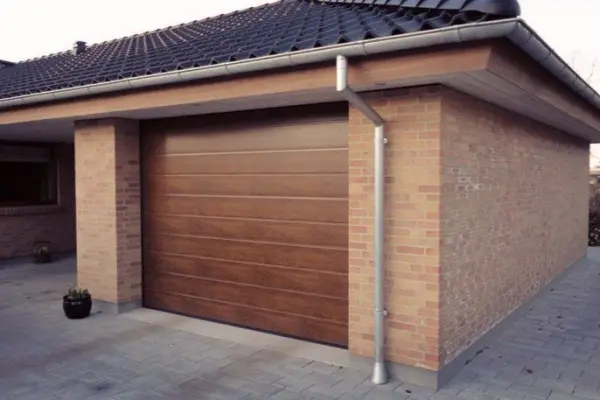Sectional garage doors have become practically a standard for modern homes. Popularity is growing. In 2024, about 70% of new lifting-sectional constructions are equipped with automatic drives — the statistics are impressive. The operating principle of sectional systems is simple: lifting sectional doors rise vertically and fold under the ceiling. Space saving — the main advantage. Unlike swing systems, lifting panels don't require additional area in front of the garage. By the way, the price for basic models starts from $800, and a complete set with automation will cost $1200-1500.
The characteristics of lifting sectional doors are impressive: service life reaches 25,000 cycles. This is reliability. Operation is designed for 15-20 years with proper maintenance — such indicators are rarely found in other types of garage systems. Thermal insulation of lifting-sectional constructions is provided by sandwich panels with polyurethane foam. Heat transfer coefficient — up to 0.38 W/m²·K. Honestly, such indicators are comparable to a brick wall 60 cm thick. In regions with cold climate, it's recommended to choose sections with thickness of 45-80 mm for maximum energy efficiency.
«When choosing garage sections, pay attention to the torsion mechanism and tension springs. They are responsible for smooth movement and durability. Quality torsion springs withstand up to 50,000 operation cycles — the investment pays off with years of trouble-free service» — advises Martin Howell, technical specialist at Clopay with 15 years of experience.
How to Choose Sectional Doors: Step-by-Step Guide
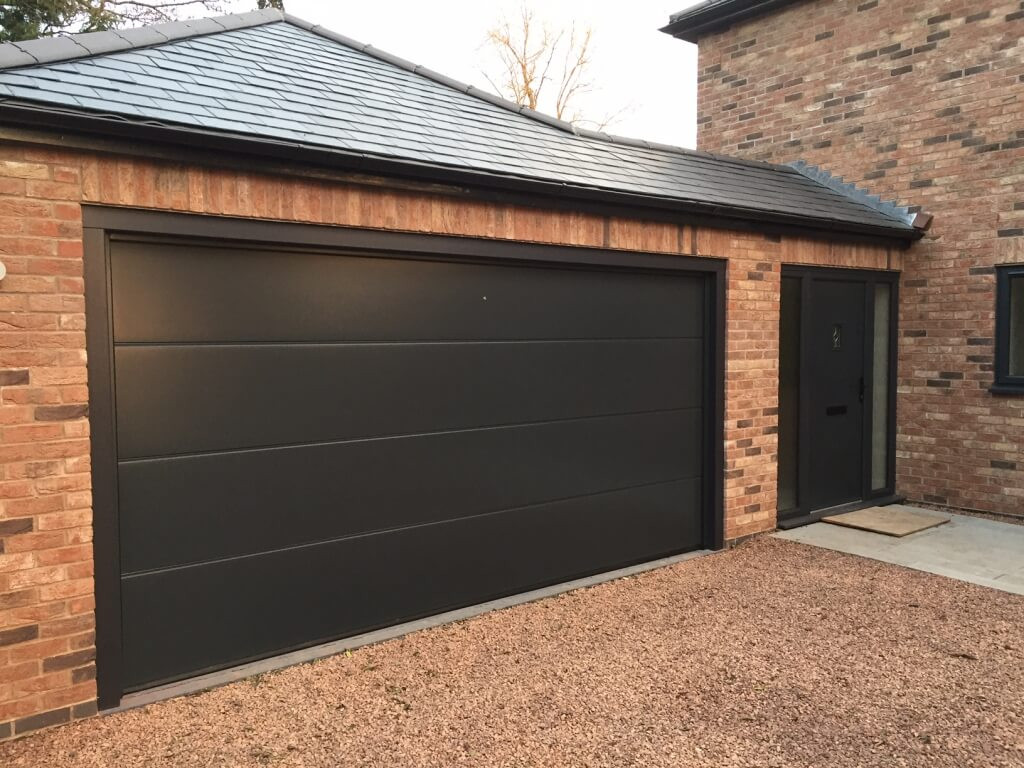 Choosing sectional garage doors requires a systematic approach. The right decision depends on the garage's technical parameters, climatic conditions, and personal preferences. Follow this step-by-step guide for optimal choice:
Choosing sectional garage doors requires a systematic approach. The right decision depends on the garage's technical parameters, climatic conditions, and personal preferences. Follow this step-by-step guide for optimal choice:
- Measure the opening — accurately determine the width, height, and depth of the garage. Consider space for side guides (120 mm on each side) and lintel (minimum 100 mm)
- Determine the lift type — standard lift requires 100-150 mm above the opening, high lift — 300-450 mm (for high ceilings), low lift — only 80-100 mm (for limited space)
- Choose panel thickness — for heated garages minimum 40 mm, for regions with cold winters — 45-80 mm
- Decide on automation — manual control is cheaper, but automatic drives are more convenient. Consider door weight when choosing drive power
- Select design — RAL color, texture (smooth, wood-like, embossed), presence of windows for natural lighting
- Check additional options — wicket door for pedestrian passage, ventilation grilles, emergency opening system
The right choice of sectional doors — is a balance between functionality, aesthetics, and budget. Consultation with professionals will help avoid typical mistakes.
Comparison of Sectional Doors with Other Types
To understand the advantages of sectional doors, it's important to compare them with other popular types of garage doors. Each option has its features that determine the scope of application:
| Parameter | Sectional | Swing | Roll-up | Sliding |
|---|---|---|---|---|
| Space saving | Excellent | Poor | Excellent | Average |
| Thermal insulation | Excellent (up to 0.38 W/m²·K) | Average | Poor | Average |
| Cost | $800-3000 | $400-1500 | $600-2000 | $1000-3500 |
| Reliability | High | Average | Average | High |
| Service life | 15-20 years | 10-15 years | 7-12 years | 15-20 years |
| Automation | Simple | Complex | Simple | Average |
| Burglar resistance | High | Low | Average | High |
Sectional doors are optimal for most private garages thanks to the combination of reliability, thermal insulation, and ease of use. Roll-up doors are suitable for unheated premises, swing ones — with limited budget and available free space.
Sectional Door Design and Key Components
 Automatic sectional systems consist of several key elements. Complicated? Not very. Guide profiles ensure section movement, roller carriages allow the canvas to move smoothly and silently. In the new Prague office, I noticed how proper installation of lifting panels reduced noise level by 20 dB — the same silence as in a library. Automation for garage sections includes ceiling drive and door control unit. Research in torsion spring physics shows that proper load calculation is critically important for construction durability.
Automatic sectional systems consist of several key elements. Complicated? Not very. Guide profiles ensure section movement, roller carriages allow the canvas to move smoothly and silently. In the new Prague office, I noticed how proper installation of lifting panels reduced noise level by 20 dB — the same silence as in a library. Automation for garage sections includes ceiling drive and door control unit. Research in torsion spring physics shows that proper load calculation is critically important for construction durability.
A comparative table of main components and their characteristics will help better understand the system design:
| Component | Function | Service life | Material | Replacement cost (USD) |
|---|---|---|---|---|
| Sandwich panels | Thermal insulation, sound insulation | 20-25 years | Steel + polyurethane foam | $200-400/panel |
| Torsion springs | Door weight compensation | 25,000-50,000 cycles | Spring steel | $150-350 |
| Guide rails | Panel movement | 30+ years | Galvanized steel | $100-200 |
| Seals | Gap sealing | 5-7 years | EPDM rubber | $50-100 |
| Electric drive | Automatic opening | 10-15 years | Metal + plastic | $300-800 |
The right choice of components directly affects the durability and reliability of the entire system.
Advantages of Sectional Doors for Modern Garage
The main advantages of lifting sectional doors — space saving and energy efficiency. Practical and profitable. Garage sections rise vertically, leaving the driveway free — this allows parking the car 10 cm from the canvas without risk of damage. Last season I observed how a neighbor with swing doors couldn't drive out after snowfall, while owners of sectional systems calmly opened their garages. Let's consider the main advantages that make lifting-sectional constructions the optimal choice:
- Space saving — vertical lift frees up to 2 meters in front of the garage, allowing to park the car close to the doors
- Energy efficiency — sandwich panels with polyurethane foam reduce heat loss by 60-70% compared to metal doors
- Safety — anti-pinch protection systems and photocells prevent injuries, and reinforced panels meet burglar resistance class RC2
- Durability — average service life 15-20 years or 25,000 opening cycles with proper maintenance
- Automation — smartphone control capability, integration with smart home systems
- All-weather operation — operation at temperatures from -40 to +50°C without loss of functionality
- Design — over 200 RAL colors, wood texture imitation, glazing option for natural lighting, garage doors with wicket for convenient passage
These characteristics make lifting sectional doors a universal solution for any climate. Types of sectional doors differ in materials, design and functionality — this allows selecting the optimal option for specific operating conditions. From experience, the right choice of construction type saves up to 30% on garage heating.
Sound insulation of sectional systems is especially important for garages attached to the house. Silence is valued. Quality panels with seals around the frame reduce noise by 20-25 dB — it's like moving from a noisy street to a quiet room. Strength and durability are provided by steel sandwich elements 40-80 mm thick. Weather resistance allows operating lifting panels at temperatures from -40 to +50°C. Additional options expand functionality: ventilation grilles prevent condensation (important for storing classic cars), emergency opening systems work during power outages, canvas position sensors increase safety.
«In early 2023, our family auto shop in Ohio suffered from old swing doors. In winter they froze, opening took 20 minutes, and heating bills grew by 30%. After installing Clopay sectional doors with 50 mm sandwich panels, heating costs decreased by 25%. Automation with remote control reduced opening time to 10 seconds. Wood-look design attracted new customers. By year's end, the customer base grew by 15%, income — by 20%. These doors literally saved our business!» — shares David Thompson, auto service owner in Ohio.
Sectional Door Safety and Protection Systems
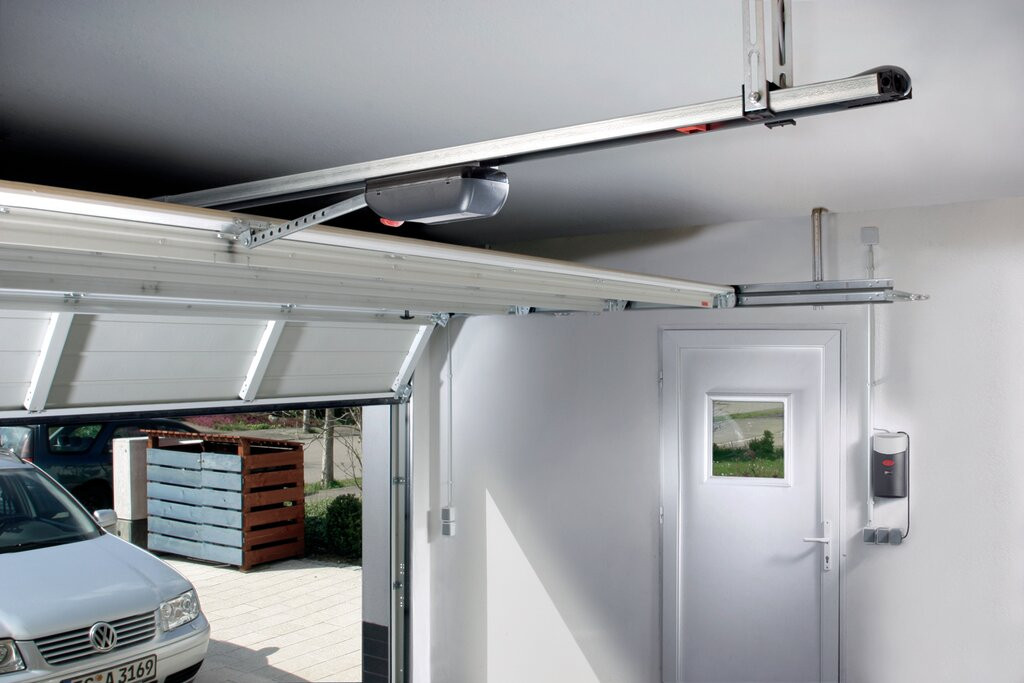 Sectional door safety is provided by several protection levels. Safety photocells stop movement when detecting obstacles. Anti-pinch protection systems prevent injuries. According to European insurance companies' statistics, less than 1% of accidents are related to automation malfunction. Such reliability is achieved thanks to modern technologies and regular maintenance.
Sectional door safety is provided by several protection levels. Safety photocells stop movement when detecting obstacles. Anti-pinch protection systems prevent injuries. According to European insurance companies' statistics, less than 1% of accidents are related to automation malfunction. Such reliability is achieved thanks to modern technologies and regular maintenance.
Door lock and reinforced panels meet burglar resistance class RC2. Last season I encountered a situation where intruders tried to break the neighbor's old swing doors. Sectional doors in neighboring garages remained untouched — too complex construction for quick penetration.
Installation and Mounting of Sectional Doors
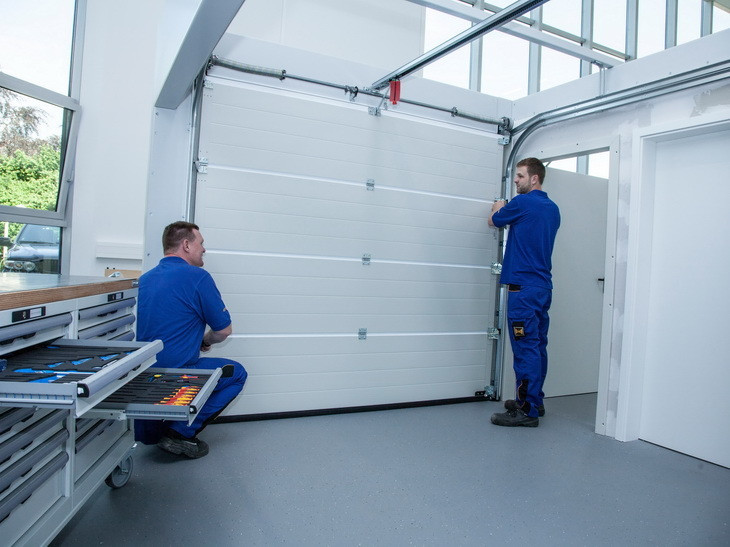 Sectional door installation requires a professional approach. Sectional door dimensions must exactly match the opening. Standard width — 2.5-6 meters, height — 2-3 meters. For proper installation, the following technical requirements must be considered:
Sectional door installation requires a professional approach. Sectional door dimensions must exactly match the opening. Standard width — 2.5-6 meters, height — 2-3 meters. For proper installation, the following technical requirements must be considered:
- Space above the opening — minimum 100-150 mm for standard lift type, 300-450 mm for high lift
- Side walls — at least 120 mm on each side for guide mounting
- Garage depth — door height plus 500-1000 mm for horizontal guide placement
- Power supply — 220V outlet at 0.5-1.5 m distance from drive installation location
- Opening strength — ability to withstand door weight (150-300 kg) plus dynamic loads
- Floor levelness — difference not more than 5 mm per meter for proper seal operation
- Ventilation — presence of supply and exhaust system to prevent condensation
Following these requirements, sectional door installation takes 4-8 hours. Turnkey sectional doors will cost $1500-3000 depending on size and configuration, which includes material cost and professional installation.
Can sectional panels be installed in a low garage? Yes, modern constructions require only 100-150 mm of space above the opening. Wicket door in the doors — convenient addition for pedestrian passage, especially in winter. Price increases by $300-500, but convenience compensates for costs. Garage doors with wicket are especially practical for large garages for several cars — no need to lift the entire canvas just to get a tool.
«When choosing sectional doors, always check sandwich panel thickness. For heated garages, I recommend minimum 40 mm. Pay attention to seals — they should be made of EPDM rubber, which doesn't lose elasticity in frosts. And most importantly — don't save on automation, quality drive will serve 10-15 years without problems» — recommends Andreas Schmidt, certified installer with experience of installing over 5000 doors.
Convenience of Using Sectional Garage Doors and Additional Features
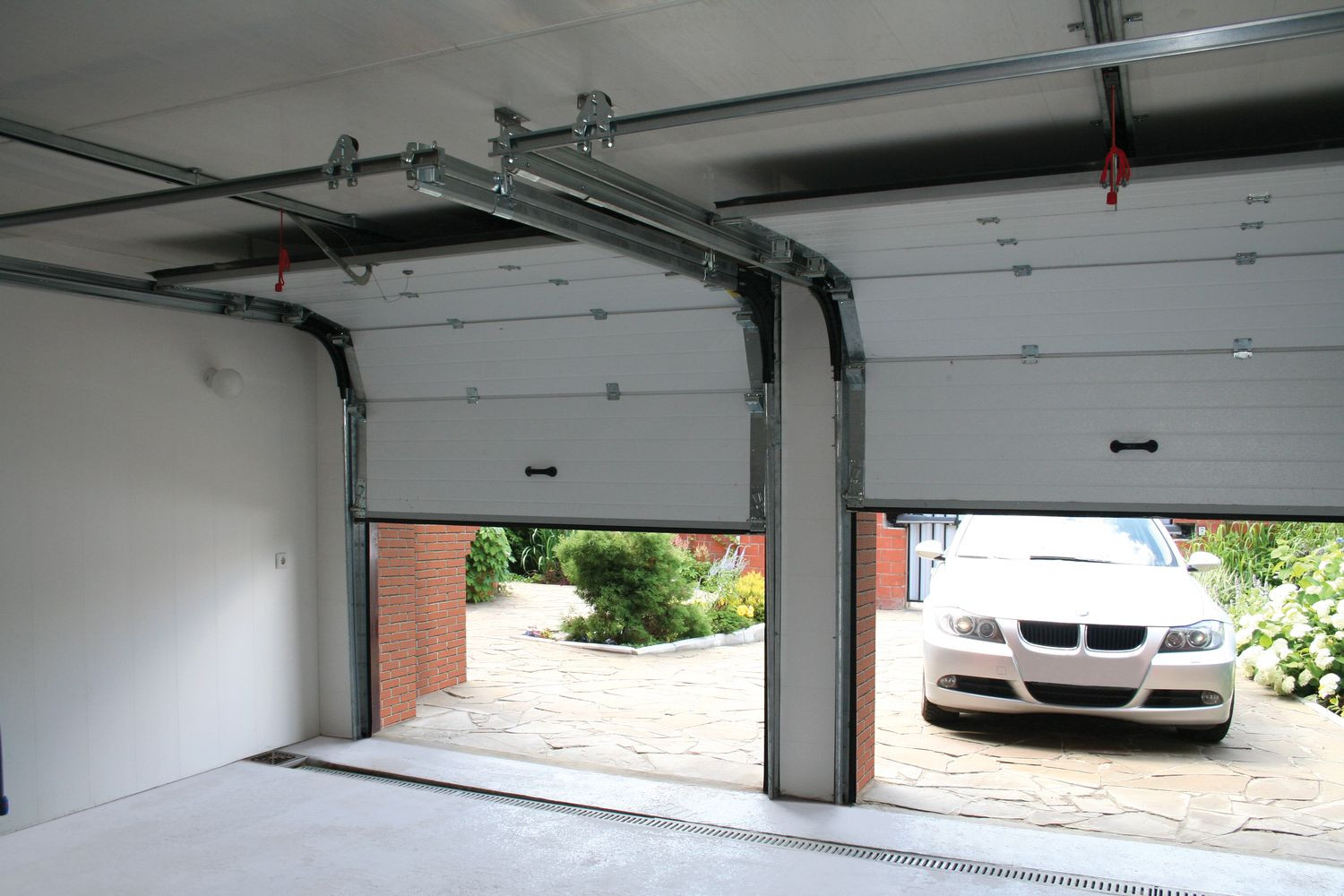 The convenience of using automatic garage doors is hard to overestimate. Modern systems support smartphone control. Smart home integration allows opening doors by voice or on schedule. By the way, about 40% of new installations in 2024 include smart home functions. Door remote control remains the most popular control method — simple and reliable.
The convenience of using automatic garage doors is hard to overestimate. Modern systems support smartphone control. Smart home integration allows opening doors by voice or on schedule. By the way, about 40% of new installations in 2024 include smart home functions. Door remote control remains the most popular control method — simple and reliable.
Design and colors of sectional doors are diverse — from classic white to imitation of expensive wood species. Manufacturers offer over 200 RAL color options. Some companies, such as Hörmann and DoorHan, create panels with individual design. Options with glazing are popular — windows let light into the garage, saving electricity during the day.
Disadvantages of Sectional Doors and Ways to Minimize Them
Disadvantages of sectional doors exist, as with any construction. The main minus — higher price compared to swing doors. The difference is 30-50%. However, savings on heating pay off the difference in 3-5 years. Door repair and maintenance is required every 1-2 years. Maintenance cost — about $100-150.
Why do sectional doors squeak? Usually the reason is lack of lubrication or roller wear. Timely maintenance prevents 90% of problems. Sectional door weight reaches 150-300 kg, which requires a strong opening. For brick walls this is not a problem, but wooden constructions may require reinforcement.
Typical Mistakes in Selection and Installation
When choosing and installing lifting-sectional constructions, owners often make mistakes. Costly. These miscalculations lead to additional expenses and operational problems — knowing typical mistakes will help save time and money:
- Incorrect measurements — error even 10-20 mm may require opening modification or ordering new doors
- Saving on panel thickness — choosing thin panels (20-30 mm) for heated garage will lead to high heat loss
- Ignoring door weight — weak drive for heavy doors will quickly fail
- Lack of ventilation — without ventilation grilles, condensation forms in the garage, leading to corrosion
- Self-installation — improper installation reduces service life by 30-50%
- Saving on automation — cheap drives often break and don't have safety functions
- Neglecting maintenance — lack of lubrication and adjustment leads to premature wear
Avoiding these mistakes will help consultation with professionals and choosing proven manufacturers with good reputation.
Sectional Garage Door Maintenance and Problem Diagnostics
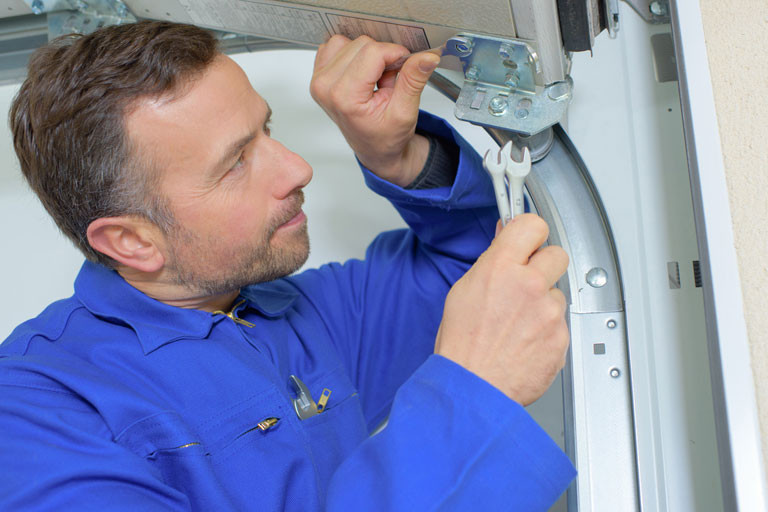 Regular sectional door maintenance extends service life and prevents expensive repairs. Basic maintenance includes simple procedures that can be performed independently:
Regular sectional door maintenance extends service life and prevents expensive repairs. Basic maintenance includes simple procedures that can be performed independently:
- Moving parts lubrication — rollers, hinges, guides every 3-6 months with silicone lubricant
- Spring tension check — visual inspection for deformation or corrosion
- Guide cleaning — dirt and debris removal with soft brush
- Seal check — replacement when cracks appear or elasticity is lost
- Automation testing — checking photocells and reverse system
Diagnosis of typical problems will help determine the need for professional repair:
- Squeaking during movement — lack of lubrication or roller wear
- Uneven movement — problems with springs or guides
- Slow opening — drive wear or power supply problems
- Gaps around perimeter — panel deformation or seal wear
- Automation doesn't work — problems with remote, drive or photocells
When serious problems are detected, it's recommended to contact certified specialists for professional diagnosis and repair.
Energy Efficiency and Environmental Friendliness of Sectional Doors
Energy efficiency of lifting sectional doors — key selection factor in 2025. Heating bills are rising. Quality thermal insulation reduces heat loss by 60-70% compared to metal swing constructions — it's like closing an open window in winter. Heat transfer coefficient of best models — 0.38 W/m²·K. According to the garage door energy efficiency guide, R-value directly affects energy savings. By the way, insulated garage — like a thermos for the car, engine warms up faster, and fuel consumption in winter decreases by 10-15%.
Environmental friendliness of modern doors is impressive. Manufacturers use recycled materials for 15-20% of components. Energy-efficient production technologies reduce carbon footprint. Service life of 20 years means less waste. How to additionally insulate sectional doors? Usually this isn't required — modern panels are already optimally insulated.
«Investment in quality sectional doors — is not only comfort, but also savings. Over 10 years of operation, you'll save on heating an amount comparable to the cost of the doors themselves. Choose models with heat transfer coefficient not higher than 0.5 W/m²·K for maximum efficiency» — states Elena Kovalchuk, energy auditor with 12 years of experience.
Popular Sectional Door Manufacturers and Models
 Hörmann sectional doors are considered the quality standard. The German manufacturer offers a 10-year warranty on panels and includes emergency opening systems in the basic configuration. DoorHan sectional doors — Russian brand with good price-quality ratio, adapted for cold climate. Alutech sectional doors are popular in Eastern Europe.
Hörmann sectional doors are considered the quality standard. The German manufacturer offers a 10-year warranty on panels and includes emergency opening systems in the basic configuration. DoorHan sectional doors — Russian brand with good price-quality ratio, adapted for cold climate. Alutech sectional doors are popular in Eastern Europe.
Automatic garage doors from Clopay (USA) are distinguished by design variety. Over 50 texture and color options. Custom sectional doors allow creating unique design. Prices for individual solutions start from $2000. Ordering sectional doors from official dealers — this guarantees quality installation and service.
Choosing sectional garage doors — investment in comfort. Decision made? Ordering sectional doors from official dealers — this guarantees quality installation and service. Properly selected lifting sectional doors will serve for decades, providing reliable protection for the car and significant heating savings. Modern technologies make the use of garage sections maximally convenient. Variety of designs and colors of sectional doors allows buying custom sectional doors, perfectly matching any architectural style.
